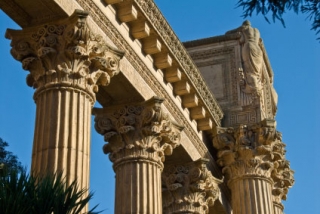A BEAUTIFUL CITY, BY DESIGN – A look at San Francisco’s architects
December 04, 2012 Filed under: The Buzz

It’s unclear who appreciates San Francisco’s architecture more -- the tourists who come and marvel at the distinctive Transamerica Pyramid, the Beaux Arts masterpiece that is City Hall and the glittering Conservatory of Flowers in Golden Gate Park, or those of us who live here and enjoy our dazzling cityscape on a daily basis.
One thing is certain, though, along with its food and fog, San Francisco is known for its architecture and architects.
Dating to its earliest days, the city has been a bastion of fine architecture, with Peter R. Schmidt’s Haas-Lilienthal House, one of the prime remaining examples of the architectural opulence of the era, leading the way. Built in 1886, the house narrowly missed destruction in the great earthquake and fire of 1906 when the blazes stopped at Van Ness Avenue, a block to the east of its Franklin Street location. Schmidt, a native of Germany who arrived in California in the middle of the 19th century on horseback, was one of the most prolific architects of his generation. Working in the Bay Area for three decades, he designed hundreds of buildings ranging from cemetery monuments to factories. Dozens of his buildings are still standing.
Look for the most important buildings around town and you’ll repeatedly see the handiwork of Willis Polk. The Pacific Union Club atop Nob Hill, the Hallidie Building, with its groundbreaking glass-curtain wall, and the iconic Hobart Building on Market Street, said to be the architect’s favorite, are among the city’s Polk-designed masterpieces. He also had a hand in renovating Mission Dolores after the 1906 earthquake and designing some of the most highly regarded mansions on the Peninsula, including the Carolands Chateau in Hillsborough, Woodside’s Filoli Estate and Le Petit Trianon in Cupertino.
For sheer civic star power, it’s hard to beat Arthur Brown Jr., who was responsible for the design of City Hall, the War Memorial Opera House, the PG&E Building and Coit Tower in San Francisco alone. Also among his accomplishments: Union Station in San Diego, Hoover Tower at Stanford University, the Andrew W. Mellon Auditorium in Washington, D.C. and a number of buildings at his alma mater, UC Berkeley, including Sproul Hall and the Bancroft Library.
But perhaps the San Francisco architect with the broadest reach was Bernard Maybeck, the designer of the domed Palace of Fine Arts, which was built for the 1915 Panama-Pacific International Exposition. Perhaps more important, he was a mentor for an entire generation of great California architects, including Brown, the legendary Julia Morgan, William Wurster and George Applegarth, who happened to design the Palace of the Legion of Honor.
Not all great San Francisco architects are relegated to history books, though. Contemporaries such as Paulett Taggart Architects and David Baker + Partners are well recognized, particularly for their sustainable design work. And SmithGroup, working with Los Angeles’ Morphosis, is responsible for the mesmerizing Federal Building that opened in 2007.
Even with all these great home-grown professionals, some of San Francisco’s most famous structures were designed by architects outside the region.
The Transamerica Pyramid is the work of Los Angeles-based William Pereira, who was known for his love of science fiction. The unique San Francisco Museum of Modern Art building is the work of Swiss architect Mario Botta and the St. Louis-based giant HOK, which also conceived of Levi’s Plaza, the Moscone Convention Center and AT&T Park.
As for the Conservatory of Flowers?
It was assembled in 1878 from a kit shipped over from England. But it’s renovation from 1999-2003 was overseen by a San Francisco firm, Architectural Resources Group.
By: sfproperties "on the beat"